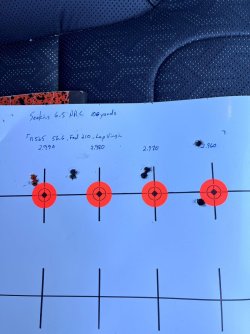If the "good" groups are over an inch, you have a mechanical issue in the rifle to work on still, or the bullet/powder match is not suitable. Sucks if you have a lot of components, but fighting a mismatch is begging to be frustrated. What does it do with factory ammo?
Personally if I got a discount rifle shooting about an inch with Red box bullets I'd call it good, stop messing around with lead development, and shoot more/further.
Yes. Group C isn't a "massive outlier" because if he repeats this same ladder test four more times there's a decent chance the other groups open up to a similar average, and even that C shoots a decent group somewhere in there. So far the rifle has shown to be at best 1.1MOA capable, and that's being generous assuming he can get repeatable results out of one of the other groups.
I know you're being sarcastic because Will said nodes are a myth, but the truth is that three shots at a time resulting in these 1MOA+ groups aren't telling him anything other the rifle isn't capable of much better than an inch right now. Tuning happens after major issues are solved. At 1MOA+ there are major issues that hide the result of load tuning. This is a 7mm-08 not a 30-375 Weatheryby, the base precision of the rifle should be better than what those groups show. If he comes back and says the rifle shoots bugholes with facotry ammo then all I'm seeing here is component mismach.
If he comes back as says factory ammo does about the same groups as this, that's what the barrel can produce. It's a Savage Axis II, not a benchrest rifle. I wouldn't waste time chasing the load any further and would start using the heck out of it how it is.
Caveat - he should find the max load for the combination. If he's still 2 grains under need to go up and hit the top and see what happens there. That's a significant amont of case volume that could change the pressure curve pretty drastically still. Maybe there's a bughole load at peak pressure.

